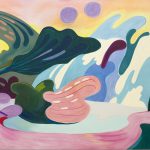Timothy Taylor is delighted to present an exhibition of paintings by Hayal Pozanti (b. 1983, Istanbul, Turkey). This is the artist’s first solo exhibition with the gallery, following an announcement of representation earlier this year. Pozanti’s exhibition will inaugurate Timothy Taylor’s new 6,000-square-foot New York gallery at 74 Leonard Street in Tribeca.
The exhibition will present lush, large-scale abstract paintings that Pozanti makes by drawing with brightly colored oil sticks, which she then blends with her fingers. For the past decade, Pozanti has been interested in the impact of technological progress on human society, creating an alphabet of 31 glyphs to translate this data into concentrated geometric paintings.
Eventually, Pozanti’s investigations led her to focus on the repercussions of human inventions on the natural world. With a growing concern for climate-related disaster, and a new interest in exploring her subconscious, Pozanti has sought a form of art that mirrors lifelike movement and natural growth. The new works begin with en-plein-air sketches of the landscapes that Pozanti encounters in travels or around her home in rural Vermont, which she abstracts on the canvas. In the final paintings, Pozanti seeks a trancelike connection between body and mind, shaping the biomorphic forms rooted in her symbolic language into sweeping visions marked by the texture of touch.
Pozanti’s original alphabet, which she compares to the building blocks of DNA, has grown into a complex ecology of channels and orbs reminiscent of waterfalls, forests, mushrooms, and flowers. In The Kin of Ata are Waiting for You (1971), a science fiction novella, Dorothy Bryant imagines a utopian community in which people design reality around ideas revealed to them in their dreams. This radical fable was a key influence on Pozanti, whose paintings reflect an idealized world based on her vision of life beyond human exceptionalism.
The exhibition’s title is drawn from a poem by Robinson Jeffers, The World for a Mirror, which reflects on the poet’s surrounding landscape as a mirror for his inner self. Jeffers’ celebration of the ferocity and freedom of wild animals, and the enduring beauty of sea, sky, and stone, sheds light on Pozanti’s own vision of the human experience as a single chord within the symphony of the universe.
The mountains, woods, and icy streams outside Pozanti’s window offer clear inspiration, while a sensual palette of golden, apricot, and rose pink in paintings such as Off To Dream Farther Away (2023) suggests a transcendent communion with the sublime. In the burning orange orbs of one cool blue canvas, we can almost hear the murmur of insects at twilight; yet Pozanti has created a fundamentally alien planet, where the ease with which unknown plants and animals grow provokes a moral reckoning in the viewer. Pozanti’s verdant world compels us to imagine the possibility of adapting to the rhythms of the earth, instead of forcing the earth to live within ours.
Press release from Timothy Taylor



